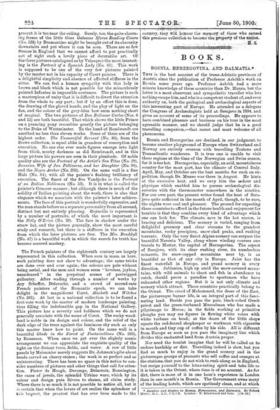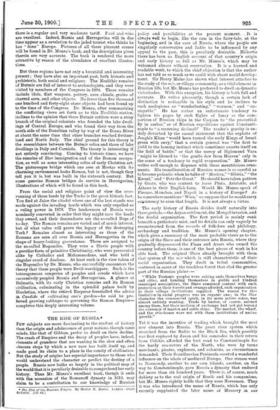BOOKS.
BOSNIA., HERZEGOVINA, AND DALXiTIA.*
Tars is the best accotm. t of the trans-Adriatic provinces of Austria since the publication of Professor Asb6th's Work on Bosnia some years ago. Professor Asb6th , had a more minute knowledge of these countries than Dr., Munro, but the latter is a most observant and sympathetic traveller who lets nothing escape him, and who is a competent student of, and even authority on, both the geological and archteological aspects of this interesting part of Europe. He attended as a delegate the Congress of Archteologists held at Serajevo in 1894, and gives an account of some of its proceedings. He appears to have combined pleasure and business on his tour in the most agreeable manner, and we should judge that he is a good travelling companion,---that rarest and most welcome of all phenomena.
Bosniaand Herzegovina are destined, in our judgment, to become another playground of Europe when Switzerland and Norway are entirely overrun with travelling Teutons and Transatlantic wanderers. It is true one is unable to visit these regions at the time of the Norwegian and Swiss season, fer it is too hot. Herzegovina, especially, an arid, mountainous country for the most part, has the climate of Central Italy. April, May, and October are the best months for such an ex- pedition, though Dr. Munro was there in August. He hints at the excessive heat, and we envy him the ardour and physique which enabled him to pursue archnological dis- coveries with the thermometer somewhere in the nineties. For our own part, the present writer found the heat of Sera- jevo quite sufficient in the month of April, though, to be sure, the nights were cool and pleasant. The ground for expecting these countries to afford in the future health and enjoyment for tourists is that they combine every kind of advantage which one can look for. The climate, save in the hot season, is bracing and delicious. The scenery is varied, ranging from delightful greenery and clear streams to the grandest mountains, rocky precipices, snow-clad peaks, and rushing torrents. Only the very finest Alpine scenery can surpass the beautiful Narenta, Valley, along whose winding courses one travels to Mostar, the capital of Herzegovina. The aspect of Serajevo, with its clear rushing river, its numberless minarets, its snow-capped mountains near by, is as beautiful as that of any city in Europe. Jake has the finest _waterfall in Europe, and grand scenery in every direction. Jablanica, high up amid the snow-covered moun- tains, with wild animals to shoot and fish in abundance to catch, should prove a paradise to sportsmen who have exhausted other regions. But it is not only climate and scenery which attract. These countries practically belong to the Orient. The creed of Mahommed, the dress of the East, the picturesque bazaar life, is an integral part of this fasci- nating land. Beside you pass the pale, black-robed- Greek priest and the green-turbaned Mussuhnan who has made a pilgrimage to Mecca; in the fields working at primitive ploughs you may see figures in flowing white robes with white turbans on head; at the doors of the little shops squats the red-fezzed shopkeeper or workman with cigarette in mouth and tiny cup of coffee by his side. All is different from Europe as soon as you pass the imaginary line which divides this enchanted land from Austria proper.
Nor need the tourist imagine that he will be called on to. endure hardship or dirt. Travelling indeed is slow, but you find so much to enjoy in the grand scenery and in the picturesque groups of peasants Who sell coffee and oranges at the stations, that you do not wish to rush along as in England, but resign yourself to the lotus-eating spirit and take life as it is taken in the Orient, where time is of no account. As for dirt, there is more of it in one hour's experience in London than in one month's in Bosnia. The Government owns many of the leading hotels, which are spotlessly clean, and at which
• .Rambles and .Studies in Bosnia, Herzegovina, and Dalmatia. By Robert Munro, M.A., M.D., F.R.S.E. London : W. Blackwood and Sons. [I2s. 6d.]
there is a regular and very mpderate tariff. Food and wine. are excellent. In,deed, Boss& and Herzegovina will in due time Appear as a revelation to the jaded tourist who thinks he has " done " Europe. Pictures of all these pleasant scenes will be found in Dr. Munro's book, and the descriptions given therein are very accurate. The book is rendered the more attractive by reason of the abundance of excellent illustra- tions.
But these regions have not only a beautiful and interesting present; they have also an important past, both historic and prehistoric, both social and religious. The Neolithic remains of Butmir are full of interest to archeologists, and they were visited by members of the Congress in 1894. These remains include- idols, flint weapons, pottery, axes, chisels, grains of charred corn, and other objects. No fewer than five thousand one hundred and forty-eight stone objects had been found up to the time of the Congress. Dr. Munro, after summarising the conflicting views set forth as to this Neolithic station, inclines to the opinion that these Butmir settlers were a stray branch of the original colonists who founded the lake dwell- ing( of Central Europe, and who found their way from the south-side of the Danubian valley by way of the Bosna River at about the same time that other branches reached Switzer- land and North Italy. The chief ground for this theory is the resemblance between the Butmir relics and those of lake dwellings in Italy and Carniola. The theory is interesting if not entirely convincing. Coming to historic times, we have the remains of Slav immigration and of the Roman occupa- tion, as well as some interesting relics of early Christian art. The picturesque bridge which one sees at Mostar with its charming environment looks Roman, but is not, though they tell you it is, but was built in the sixteenth century. But some genuine Roman bridges do survive in Herzegovina, illustrations of which will be found in this book.
From the social and religious point of view the over- running of these lands by the Turks is the great historic fact. You find at Jaice the citadel where one of the last stands was made against the invading horde which was only expelled as a ruling power in 1878. The landowners of Bosnia were nominally converted in order that they might save the lands they owned, and their descendants are the so-called Begs of to-day. The Roman remains are varied and of much interest, but of what value will prove the legacy of the destroying Turk Remains almost as interesting as those of the Romans are seen all over Bosnia and Herzegovina. in the shape of hoary-looking gravestones. These are assigned to the so-called ,Bogomiles. They were a Slavic people with a peculiar form of primitive Christianity, who were persecuted alike by Catholics and Malommedans, and who held a singular creed of dualism. At least such is the view taken of the Bogomiles by Dr. Munro, who successfully encounters the theory that these people were Devil-worshippers. Such is the heterogeneous congeries of . peoples and creeds which have successively peopled Bosnia and Herzegovina. A glance at Dalmatia, with its early Christian remains and its Roman civilisation, culminating in the splendid palace built. by Diocletian, where the retired Emperor forestalled the advice in Candi& of cultivating one's garden—he said he pre- ferred growing cabbages to governing the Roman Empire— completes this deeply interesting volume.



















































 Previous page
Previous page